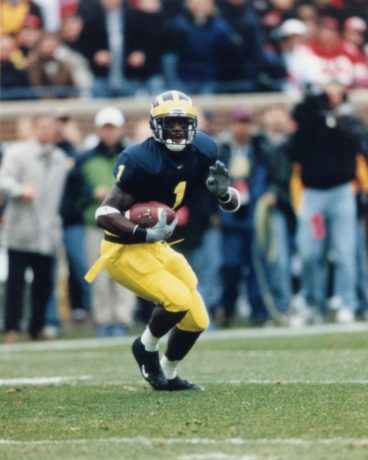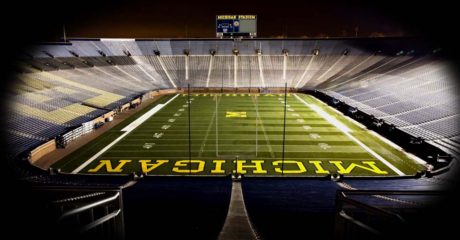 |
| Desmond Howard |
Touch The Banner,
As you know you put Mario Manningham as your Former Michigan Athlete of the week, and it reminded me of a question I’ve always wanted to ask a fellow Michigan fan. Since the time of Braylon Edwards we haven’t had a WR wear the #1 Jersey. If you had to look back on the receivers we’ve had, which one would you think would be the most deserving of the #1 jersey?
From,
Michigan Fan from Dayton, Ohio
The origin of the #1 jersey tradition stems from Braylon Edwards in the early 2000s. Edwards requested the #1 jersey to honor his childhood hero, Anthony Carter. Carter had been a receiver who wore the #1 at Michigan from 1979-1982. Since Carter’s time at Michigan, five players have worn the #1. All have been wide receivers – Greg McMurtry, Derrick Alexander, Tyrone Butterfield, David Terrell, and Edwards. For some perspective, here are their career statistics:
1. Carter: 161 receptions, 3076 yards, 19.1 yard average, 37 touchdowns; 25.5 yards per kick return; 11.5 yards per punt return, 2 touchdowns
2. McMurtry: 111 receptions, 2163 yards, 19.5 yard average, 15 touchdowns
3. Alexander: 125 receptions, 1977 yards, 15.8 yard average, 22 touchdowns; 12.7 yards per punt return, 4 touchdowns
4. Butterfield: 4 receptions, 68 yards, 17.0 yard average, 0 touchdowns
5. Terrell: 152 receptions, 2317 yards, 15.2 yard average, 23 touchdowns
6. Edwards: 252 receptions, 3541 yards, 14.1 yard average, 39 touchdowns
But it was Edwards who turned the #1 into what it is today. After requesting that number before his junior season, head coach Lloyd Carr told him that he would have to earn it, so as not to disrespect his childhood hero; Edwards was going to have to work hard on the field and become a leader in order to exchange his #80 for #1. Edwards, who had suffered from inconsistency and suspect hands up to that point, stepped up his game and his leadership, and with a good deal of hype, was awarded the #1 jersey prior to his junior season in 2003.
As far as I see it, there are several candidates to discuss who might have been worthy of the #1 jersey. Here’s how I would rank them and my thoughts on whether they were deserving of the hallowed jersey number:
1. Desmond Howard (1989-91), #21. Howard was the country’s most electrifying player in 1991, scoring 19 receiving touchdowns, 1 punt return touchdown, and 1 kickoff return touchdown. He also caught 62 passes for 985 yards for an average of 15.9 yards a catch that season. And all of those accomplishments came on the heels of a 1,000-yard season in 1990. In addition to his receiving skills, he averaged 13.8 yards a carry on 23 attempts in his three seasons, scoring 2 touchdowns. He also averaged 26.9 yards a kickoff return and 13.0 yards per punt return. Oh yeah, and he won some kind of trophy or something.
My vote: Worthy
2. Amani Toomer (1992-1995), #18. Toomer is a tough one. Michigan’s offense evolved throughout the 1990s into the mid-2000s, from a 3-yards-and-a-cloud-of-dust mentality to a we’ll-chuck-the-ball-whenever-we-feel-like-it mentality. Toomer was still in that early phase and played with the likes of Tyrone Wheatley and Tshimanga Biakabutuka, two stellar running backs. Toomer wasn’t particularly big or fast, but Michigan’s powerful running game opened up plenty of space downfield for the quarterbacks to throw. As a junior, he gained 1,096 yards despite only catching 54 passes. He then capped his career with 44 catches, 758 yards, and a career-best 7 touchdowns in 1995.
My vote: Worthy
3. Marquise Walker (1998-2001), #4. As a junior, Walker was the second receiver behind David Terrell and still managed to grab 49 passes for 699 yards and 4 touchdowns. Walker stepped it up another notch as a senior, totaling 86 catches for 1,143 yards and 11 touchdowns once Terrell had moved on to the NFL. He had six 100-yard games despite being the only significant receiving threat, including 15 catches, 160 yards, and 2 touchdowns against Ohio State that year.
My vote: Not worthy
4. Tai Streets (1995-1998), #86. Streets had a solid sophomore season during which he caught 44 passes for 730 yards and 2 touchdowns. He suffered from an injury late in his junior season, which helped limit him to 28 catches for 476 yards and 6 touchdowns; however, he had 4 receptions for 127 yards and 2 touchdowns (including a 58-yarder) in the Rose Bowl game against Washington State that propelled Michigan to a national title. As a senior, Streets had 67 catches for 1,035 yards and 11 touchdowns.
My vote: Not worthy
5. Jason Avant (2002-2005), #8. For his first three seasons, Avant played second fiddle to Braylon Edwards. He notched only two receptions in 2002 (hello, burned redshirt) and then had 85 catches spread over his sophomore and junior seasons. Once Edwards went off to the NFL, Avant caught 82 balls for 1,007 yards and 8 touchdowns. He was very reliable; I only remember him dropping one pass in a Michigan uniform, and I was astounded. But he only averaged 12.3 yards a catch as a senior. Reliable, but not a gamebreaker.
My vote: Not worthy
6. Mario Manningham (2005-2007), #86. Manningham burst onto the scene as a freshman in 2005, when he caught the game-winning score from Chad Henne against Penn State. He averaged 18.5 yards a catch and scored 9 touchdowns as a sophomore, then followed that up with a 72-catch, 1,137-yard, 12-touchdown effort in 2007. He had a couple stellar games against Notre Dame in his career and caught a 97-yard touchdown pass from Ryan Mallett toward the end of 2007. Those are great numbers. Except Manningham struggled with off-the-field issues while at Michigan, which got him suspended for one game in 2007 and ultimately caused him to drop in the 2008 NFL draft. If Edwards had to work harder and become a leader, Manningham certainly wasn’t deserving of the honor.
My vote: Not worthy
7. Steve Breaston (2003-2006), #15. Breaston is one of those players about whom you think, “I bet he was a stud in college now that he’s having 1,000-yard seasons in the NFL.” He’s having a solid NFL career with the Arizona Cardinals, but his numbers as a receiver were far from spectacular in college. Granted, his career overlapped those of Edwards, Avant, and Mario Manningham, so opportunities were scarce. Still, Breaston averaged just 39 receptions, 424 yards, and 2.5 touchdowns a season in a career where he saw significant playing time every single year. His biggest asset was his return ability, which saw him average 24.6 yards on kick returns and 12.6 on punt returns, with 5 total touchdowns. Any team would love to have him as a second or third wideout, but his limited production and iffy hands prevent him from being a #1 guy.
My vote: Not worthy
8. Mercury Hayes (1992-1995), #8. Hayes was a solid but unspectacular receiver who played alongside Toomer for all four years at Michigan. He had an outstanding senior season in 1995, with 48 catches for 923 yards (19.2 yards per catch) and 4 touchdowns. But the preceding years were just mediocre, and he didn’t offer much in the way of versatility (running, returning punts and kicks) to give him the nod.
My vote: Not worthy
SUMMARY
Statistics obviously don’t tell the whole story. If you go by touchdowns only, the trio of Edwards, Carter, and Howard are the only receivers with 30+ career touchdowns. If you go by yardage, well, there are a fair number of 1,000 yard receivers, too (Streets, Walker, Avant, Manningham). A big part of the #1 jersey seems to be “feel.” How dominant was the player? Was he a one-man wrecking crew? Was he a leader? Was he the quarterback’s go-to guy?
It’s also difficult to judge who’s worthy of the #1 jersey because, frankly, Derrick Alexander (who had mediocre statistics) and Tyrone Butterfield (who barely played, period) skew the statistics significantly. If those two players arrived on campus in the post-Braylon years, neither one would get the #1.
I gave the nod to Desmond Howard because he was clearly a dominant player, won the Heisman trophy, and set Michigan’s record for receiving touchdowns in a season. I also gave the nod to Amani Toomer, which was tough to decide; while he didn’t have an overwhelming senior season, he did have 1,000 yards as a junior and averaged over 20 yards a pop. He could easily have been awarded the #1 jersey for his senior season like Braylon, but then would have put forth an underwhelming senior year.
The senior versions of Tai Streets and Marquise Walker were both worthy of the #1 jersey by post-Braylon standards. But their mediocre seasons as underclassmen meant that they didn’t reach that status until their senior years were completed.
Oddly enough, Mario Manningham was perhaps the second-most talented player on this list, despite coming in at #6. From a purely athletic standpoint, I would rank Manningham just behind Desmond Howard on this list, and ahead of #1 jersey wearers like Alexander, Butterfield, McMurtry, and even Terrell. Unfortunately, he falls down the list because of his off-the-field issues. If Braylon Edwards couldn’t get the jersey until he proved himself as a worker and leader, then Manningham clearly never reached that point.
It’s difficult to compare across generations. Michigan’s offense, the rules of college football, and the overall philosophies of football have changed immensely in the last 20+ years. But using hindsight to look back across the past two decades, I only see two additional players who were deserving of the #1.



